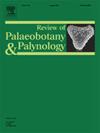Rare species in past pollen records and herbarium specimens: Linnaea borealis L. lived in north-eastern lowlands in Italy during the Neolithic
IF 1.7
3区 地球科学
Q2 PALEONTOLOGY
引用次数: 0
Abstract
This paper emphasises the role of detailed pollen identification in past records and the importance of historical herbaria in palaeoecological research on plant distribution over the last millennia. Palynological analyses of a sediment core, covering approximately the last 10,000 years, from the wetland surrounding the UNESCO archaeological site of Palù di Livenza, in the lowlands of Friuli-Venezia Giulia, revealed the unexpected presence of Linnaea borealis during the Mid-Holocene (about 8600–4200 cal yr BP) in north-eastern Italy. This species is a rare small suffruticose plant which grows among mosses in conifer and mixed forests, between 1200 and 2100 m a.s.l. In Italy, due to the restricted climatic requirements, its current distribution is limited to a few high-mountain stands and to four northern regions (Val d'Aosta, Piedmont, Trentino-Alto Adige, Lombardy). Pollen grains of L. borealis found in past samples from the Friuli-Venezia Giulia region raised interest because this species was not recorded so far in this region either at present or in the past. To confirm the identification, a morphological study was carried out on pollen from flowers collected from University Herbaria (Florence and Pisa). Dried pollen extracted from anthers was acetolysed and observed with a Digital Optical Microscope. Polar axis, equatorial axis, exine thickness, equatorial diameters, mesocolpium, and distance among apices of colpi were measured in current and past pollen grains. Morphological analysis confirms the presence of L. borealis in the sedimentary archive studied, adding an important insight into the knowledge of past and present biodiversity of the area.
过去花粉记录和植物标本室标本中的稀有物种:新石器时代生活在意大利东北部低地的北方林草
本文强调了花粉详细鉴定在过去记录中的作用,以及历史植物标本库在近千年植物分布古生态研究中的重要性。在联合国教科文组织考古遗址Palù di Livenza周围的湿地,在Friuli-Venezia Giulia的低地,对沉积物岩心进行了大约10000年的孢粉学分析,揭示了在意大利东北部全新世中期(约8600-4200 cal yr BP), Linnaea borealis的意外存在。本种是一种罕见的小型湿性植物,生长在海拔1200米至2100米之间的针叶林和混交林中的苔藓中。在意大利,由于气候要求有限,其目前的分布仅限于少数高山林分和四个北部地区(Val d'Aosta, Piedmont, Trentino-Alto Adige,伦巴第)。在弗留利-威尼斯-朱利亚地区过去的样品中发现的北方松花粉粒引起了人们的关注,因为该地区目前和过去都没有记录到该物种。为了证实这一鉴定,对从佛罗伦萨和比萨大学植物标本室收集的花粉进行了形态学研究。从花药中提取干花粉进行乙酰化,用数码光学显微镜观察。测定了现在和过去花粉粒的极轴、赤道轴、外壁厚度、赤道直径、中胚轴和胚轴尖间距离。形态学分析证实了L. borealis在研究的沉积档案中的存在,为该地区过去和现在的生物多样性知识增加了重要的见解。
本文章由计算机程序翻译,如有差异,请以英文原文为准。
求助全文
约1分钟内获得全文
求助全文
来源期刊
CiteScore
3.50
自引率
21.10%
发文量
149
审稿时长
6 months
期刊介绍:
The Review of Palaeobotany and Palynology is an international journal for articles in all fields of palaeobotany and palynology dealing with all groups, ranging from marine palynomorphs to higher land plants. Original contributions and comprehensive review papers should appeal to an international audience. Typical topics include but are not restricted to systematics, evolution, palaeobiology, palaeoecology, biostratigraphy, biochronology, palaeoclimatology, paleogeography, taphonomy, palaeoenvironmental reconstructions, vegetation history, and practical applications of palaeobotany and palynology, e.g. in coal and petroleum geology and archaeology. The journal especially encourages the publication of articles in which palaeobotany and palynology are applied for solving fundamental geological and biological problems as well as innovative and interdisciplinary approaches.

 求助内容:
求助内容: 应助结果提醒方式:
应助结果提醒方式:


